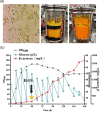Enhanced β-carotene production in Yarrowia lipolytica through the metabolic and fermentation engineering
- PMID: 37055369
- PMCID: PMC10124129
- DOI: 10.1093/jimb/kuad009
Enhanced β-carotene production in Yarrowia lipolytica through the metabolic and fermentation engineering
Abstract
β-Carotene is a kind of high-value tetraterpene compound, which shows various applications in medical, agricultural, and industrial areas owing to its antioxidant, antitumor, and anti-inflammatory activities. In this study, Yarrowia lipolytica was successfully metabolically modified through the construction and optimization of β-carotene biosynthetic pathway for β-carotene production. The β-carotene titer in the engineered strain Yli-C with the introduction of the carotenogenesis genes crtI, crtE, and crtYB can reach 34.5 mg/L. With the overexpression of key gene in the mevalonate pathway and the enhanced expression of the fatty acid synthesis pathway, the β-carotene titer of the engineered strain Yli-CAH reached 87 mg/L, which was 152% higher than that of the strain Yli-C. Through the further expression of the rate-limiting enzyme tHMGR and the copy number of β-carotene synthesis related genes, the β-carotene production of Yli-C2AH2 strain reached 117.5 mg/L. The final strain Yli-C2AH2 produced 2.7 g/L β-carotene titer by fed-batch fermentation in a 5.0-L fermenter. This research will greatly speed up the process of developing microbial cell factories for the commercial production of β-carotene.
One-sentence summary: In this study, the β-carotene synthesis pathway in engineered Yarrowia lipolytica was enhanced, and the fermentation conditions were optimized for high β-carotene production.
Keywords: Yarrowia lipolytica; Fatty acid pathway; Fermentation engineering; MVA pathway; Metabolic engineering; β-Carotene.
© The Author(s) 2023. Published by Oxford University Press on behalf of Society of Industrial Microbiology and Biotechnology.
Conflict of interest statement
The authors declare that they have no known competing financial interests or personal relationships that could have appeared to influence the work reported in this paper.
Figures







Similar articles
-
Metabolic engineering of β-carotene biosynthesis in Yarrowia lipolytica.Biotechnol Lett. 2020 Jun;42(6):945-956. doi: 10.1007/s10529-020-02844-x. Epub 2020 Feb 24. Biotechnol Lett. 2020. PMID: 32090297
-
Morphological and Metabolic Engineering of Yarrowia lipolytica to Increase β-Carotene Production.ACS Synth Biol. 2021 Dec 17;10(12):3551-3560. doi: 10.1021/acssynbio.1c00480. Epub 2021 Nov 11. ACS Synth Biol. 2021. PMID: 34762415
-
Concomitant Production of Erythritol and β-Carotene by Engineered Yarrowia lipolytica.J Agric Food Chem. 2023 Aug 2;71(30):11567-11578. doi: 10.1021/acs.jafc.3c03033. Epub 2023 Jul 19. J Agric Food Chem. 2023. PMID: 37466300
-
Advances in the metabolic engineering of Saccharomyces cerevisiae and Yarrowia lipolytica for the production of β-carotene.Crit Rev Biotechnol. 2024 May;44(3):337-351. doi: 10.1080/07388551.2023.2166809. Epub 2023 Feb 13. Crit Rev Biotechnol. 2024. PMID: 36779332 Review.
-
[Advances in efficient biosynthesis of erythritol by metabolic engineering of Yarrowia lipolytica].Sheng Wu Gong Cheng Xue Bao. 2024 Mar 25;40(3):665-686. doi: 10.13345/j.cjb.230391. Sheng Wu Gong Cheng Xue Bao. 2024. PMID: 38545970 Review. Chinese.
Cited by
-
Strategies for the Development of Industrial Fungal Producing Strains.J Fungi (Basel). 2023 Aug 8;9(8):834. doi: 10.3390/jof9080834. J Fungi (Basel). 2023. PMID: 37623605 Free PMC article. Review.
-
Combinatorial metabolic engineering of Yarrowia lipolytica for high-level production of the plant-derived diterpenoid sclareol.Microb Cell Fact. 2025 May 16;24(1):110. doi: 10.1186/s12934-025-02744-7. Microb Cell Fact. 2025. PMID: 40380140 Free PMC article.
-
Substrate-dependent lipid and β-carotene production in engineered Yarrowia lipolytica: a comparative study.AMB Express. 2025 Feb 8;15(1):27. doi: 10.1186/s13568-025-01834-4. AMB Express. 2025. PMID: 39921801 Free PMC article.
-
Industrially Important Fungal Carotenoids: Advancements in Biotechnological Production and Extraction.J Fungi (Basel). 2023 May 16;9(5):578. doi: 10.3390/jof9050578. J Fungi (Basel). 2023. PMID: 37233289 Free PMC article. Review.
-
Progress in the Metabolic Engineering of Yarrowia lipolytica for the Synthesis of Terpenes.Biodes Res. 2024 Nov 12;6:0051. doi: 10.34133/bdr.0051. eCollection 2024. Biodes Res. 2024. PMID: 39534575 Free PMC article. Review.
References
-
- Bu X., Lin J. Y., Cheng J., Yang D., Duan C. Q., Koffas M., Yan G. L. (2020). Engineering endogenous ABC transporter with improving ATP supply and membrane flexibility enhances the secretion of beta-carotene in Saccharomyces cerevisiae. Biotechnology for Biofuels, 13,1, 168. 10.1186/s13068-020-01809-6 - DOI - PMC - PubMed
MeSH terms
Substances
Grants and funding
- 2019YFA0905700/National Key Research and Development Program of China
- 22078151/National Natural Science Foundation of China
- CX(21)3120/Jiangsu Agricultural Science and Technology Independent Innovation Fund Project
- XTD2215/Jiangsu Synergetic Innovation Center for Advanced Bio-Manufacture
- YESS20200174/China Association for Science and Technology
LinkOut - more resources
Full Text Sources

